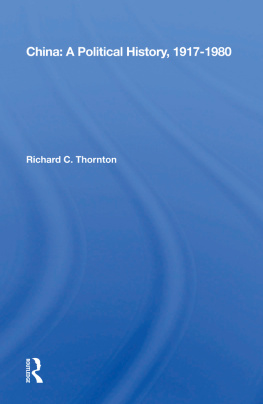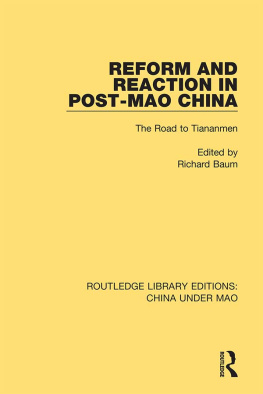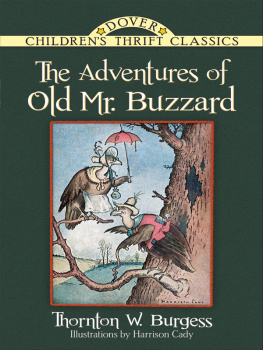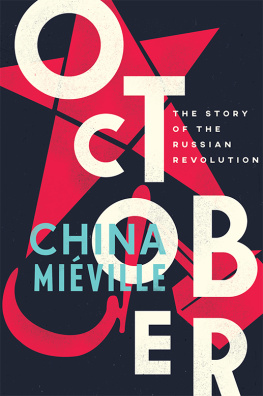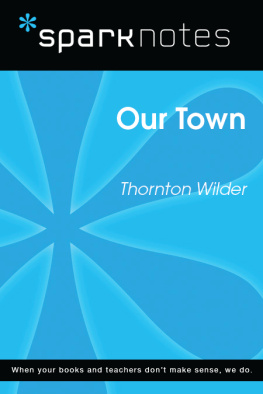CHINA: A Political History, 1917-1980_______
Also of Interest
China in World Affairs; The Foreign Policy of the PRC Since 1970, Golam W. Choudhury
China Briefing, 1981, edited by Robert B. Oxnam and Richard C. Bush
China's Economic Development: Growth and Structural Change, Chu-yuan Cheng
Technology, Politics, and Society in China, Rudi Volti
The Chinese Military System: An Organizational Study of the Chinese People's Liberation Army, Second Edition, Revised and Updated, Harvey W. Nelsen
The Forgotten Ambassador: The Reports of John Leighton Stuart, 1946-1949, edited by Kenneth W. Rea and John C. Brewer
China, the Soviet Union, and the West: Strategic and Political Dimensions for the 1980s, edited by Douglas T. Stuart and William T. Tow
China's Quest for Independence: Policy Evolution in the 1970s, edited by Thomas Fingar and the Stanford Journal of International Studies
Huadong: The Story of a Chinese People's Commune, Gordon Bennett
Law Without Lawyers: A Comparative View of Law in the United States and China, Victor H. Li
The People's Republic of China: A Handbook, edited by Harold C. Hinton
China's Four Modernizations: The New Technological Revolution, edited by Richard Baum
China at the Crossroads: Nationalists and Communists, 1927-1949, edited by Gilbert F. Chan
Treaties of the People's Republic of China , 1949-1978: An Annotated Compilation, Grant F. Rhode and Reid E. Whitlock
Chinese Communist Power and Policy in Xinjiang, 1949-1977, Donald H. McMillen
Painting in the People's Republic of China: The Politics of Style , Arnold Chang
The Chinese Agricultural Economy, edited by Randolph Barker and Radha P. Sinha
Food for One Billion: China's Agriculture Since 1949, Robert C. Hsu
Economic Reform in the PRC: In Which China's Economists Make Known What Went Wrong, Why, and What Should Be Done About It, edited and translated by George C. Wang
Available in hardcover and paperback.
About the Book and Author
CHINA: A Political History, 1917-1980
Richard C. Thornton
The People's Republic of China is changing. It is modernizing, shifting ideological gears, becoming realistic about development needs and goals, and moving away from its isolationist past toward a much more open and pragmatic assessment of its present and future position in the world. In the post-Mao period, China also seems to be willing to engage, albeit reluctantly, in the painful internal reshuffling of priorities and functions necessary to speed development. But change has not been easy: there have been major problems, both domestic and international.
Richard Thornton puts the events of the past eight years in China into historical perspective in this updated and expanded version of his textbook on China's political history since 1917 (first published in 1973 as China: The Struggle for Power, 1917-1972). With the additional material, the book now stands as the most detailed account available. Professor Thornton deals with every significant issue that has confronted the leaders of revolutionary China and discusses the origins of the People's Republic. How did communism first take root in China? How did Mao first gain control of the Communist movement? What were the ingredients of Mao's victory and emergence as the undisputed master of the most populous country in the world? What was the origin of the Sino-Soviet alliance and what caused its collapse in the fifties? And in what sense were the tumultuous events of the Cultural Revolution of the sixties a prelude to the emergence of the new pragmatism and the Sino-U.S. rapprochement in the seventies? There has been very little stability in China's recent past, but Professor Thornton points out that there has been a historical logic in the sequence of China's history. An awareness of this logic is vital to understanding China's future.
Richard C. Thornton is now professor of history and international affairs at the Institute for Sino-Soviet Studies, George Washington University, and previously was a research associate at the Far Eastern and Russian Institute, University of Washington-Seattle. He is the author of numerous books and articles on Russian, Chinese, and U.S. affairs including The Bear and the Dragon, Sino-Soviet Relations and the Political Evolution of the Chinese People's Republic, and The Comintern and the Chinese Communists.
China: A Political History, 1917-1980
Richard C. Thornton
First published 1982 by Westview Press
Published 2018 by Routledge
52 Vanderbilt Avenue, New York, NY 10017
2 Park Square, Milton Park, Abingdon, Oxon OX14 4RN
Routledge is an imprint of the Taylor & Francis Group, an informa business
Copyright 1982 by Taylor & Francis
All rights reserved. No part of this book may be reprinted or reproduced or utilised in any form or by any electronic, mechanical, or other means, now known or hereafter invented, including photocopying and recording, or in any information storage or retrieval system, without permission in writing from the publishers.
Notice:
Product or corporate names may be trademarks or registered trademarks, and are used only for identification and explanation without intent to infringe.
Library of Congress Cataloging in Publication Data
Thornton, Richard C.
China, a political history, 1917-1980.
Rev. ed. of: China, the struggle for power, 1917-1972. 1973.
Bibliography: p.
Includes index.
1. ChinaPolitics and government1912-1949. 2. ChinaPolitics and government1949
. 3. CommunismChinaHistory. I. Title.
DS775.7.T48 1982 951.04 81-21885
ISBN 0-86531-197-8 AACR2
ISBN 13: 978-0-367-01869-6 (hbk)
To
Joanne
History is the record of man's achievement and aspiration; the task of the historian is to measure the one in terms of the other.
R.C.T.
Contents
- Part I
The Origin and Development of Chinese Communism, 1917-1941 - Part II
The American Experience in China, 1941-1949 - Part III
The Sino-Soviet Relationship, 1949-1968 - Part IV
The Evolution of U.S.-China Relations, 1969-1980
- Part I
The Origin and Development of Chinese Communism, 1917-1941 - Part II
The American Experience in China, 1941-1949 - Part III
The Sino-Soviet Relationship, 1949-1968 - Part IV
The Evolution of U.S.-China Relations, 1969-1980
Guide
It is the purpose of this work to provide an integrated analytical framework that will serve as a guide to further study of the vast and complex subject of Chinese Communist politics. The outpouring of materials from U.S., Soviet, Chinese Communist, and Chinese Nationalist sources in recent years has greatly enriched our fund of knowledge about China. For the historian of Chinese politics the new data have provided answers to hitherto unresolved problems and raised questions about seemingly settled issues. Although it is now possible to piece together the main outlines of the struggle for power in China, obviously no single volume can presume to encompass all aspects of the story.
Selection of topic and theme being unavoidable, I have chosen to emphasize two pervasive themes and four separate but related topics that seem to me to form an especially important underpinning for our understanding of Chinese political history. The two principal themes intertwine at virtually every critical point in the story. One is the tremendous impact that external forces have had on the course of events in China, particularly the impact of the Soviet Union as well as that of the United States and Japan on the decision-making process of the Chinese Communist Party. Soviet involvement in the political evolution of Chinese Communism has been continuous and has helped to create the very basis for the conflicts described in this book. An ideological and organizational heritage from the USSR conditioned the initial orientation of the People's Republic of China toward the Soviet Union. Chinese leaders, whether trained in Moscow (as many were) or not, operated within the political parameters of the international Communist movement-a factor that greatly shaped the policy alternatives they perceived to be open to them. They were obliged to determine policy in terms of China's relationship with the Soviet Union. Even when they subsequently made the decision to develop independently of the Soviets, the new alternatives were also shaped to a great extent by that relationship. The choice was never between Communism and Democracy; rather the issue was, should there be greater or less Soviet influence and control over Chinese affairs? The decision was in favor of the latter alternative, but the cost was high, particularly in terms of China's economic development.


